When we talk about low light conditions for plants, we’re referring to areas where the plant doesn’t get direct sunlight. Imagine the plant hanging out a few feet away from a window, getting less light than outdoors.
Here’s the lowdown on low-light conditions:
- Low-light areas are usually about seven feet or more away from windows. This could also mean places without any natural light, like some offices.
- In low light conditions, it might be tough to read comfortably without straining your eyes. You might even feel like flipping the light switch on.
- But low light doesn’t mean no light at all. It can include that cozy ambient glow from incandescent bulbs, fluorescent lights, or LED lights. It can actually help plants not just survive but thrive in windowless rooms like bathrooms.
Below, we share 12 Top plants for low-light areas.
Epipremnum Aureum (Pothos)
Botanical Name: Epipremnum aureum
Common Name: Pothos, Golden Pothos, Devil’s Vine, Devil’s Ivy
Pothos is a tropical vine native to the Solomon Islands. It’s known for its adaptability and low maintenance. The Pothos feature pointed, heart-shaped leaves that may be variegated with white, yellow, or pale green.
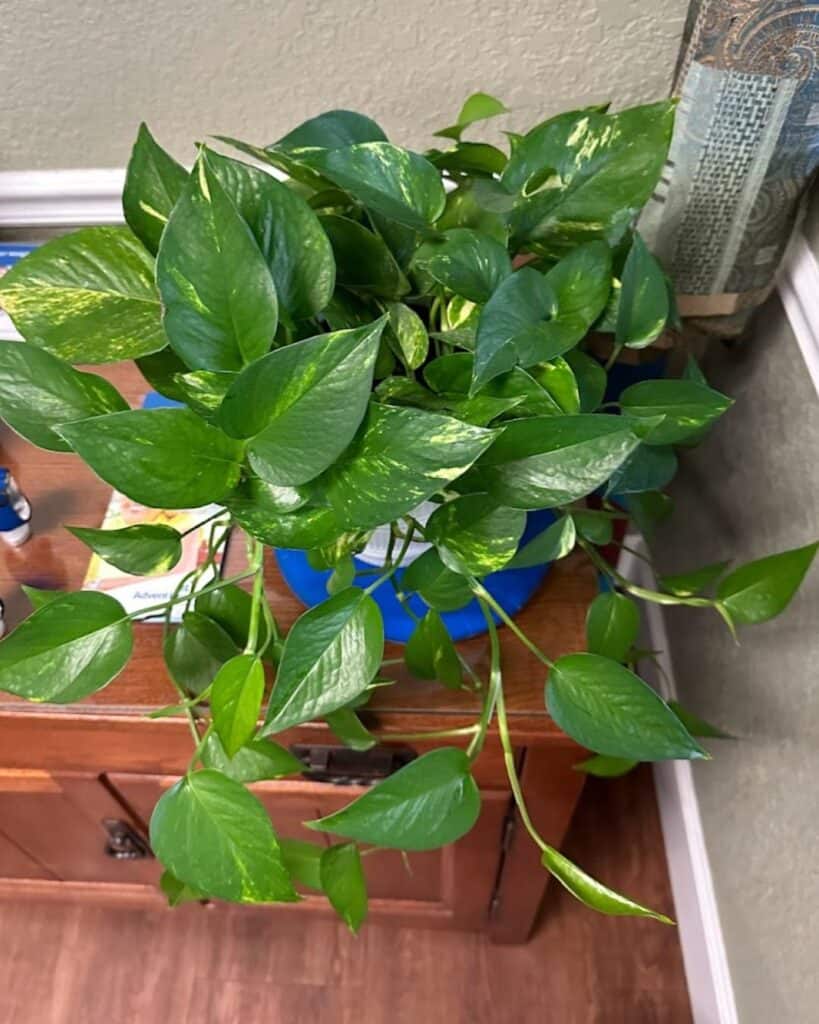

QUESTIONS
- How much light does Pothos need? Pothos thrives in low—to bright-light conditions, making it perfect for rooms with limited natural light.
- How big does Golden Pothos grow? When planted outdoors, Pothos plants can grow up to 40′ feet long. As an indoor houseplant, a Pothos with pruning can stay at a manageable size.
- How easy is Devil’s Vine to care for? Devil’s Vine is considered easy to care for. It requires occasional watering and minimal pruning, making it a great choice for busy people or those new to plant care.
- What are the different varieties of Pothos? There are several popular varieties, including ‘Marble Queen‘ (white and green variegation), ‘Pearls and Jade‘ (gray, green, and white variegation), and ‘Neon‘ (bright chartreuse leaves). Each Pothos variety has its own unique charm, so you can choose the one that suits your style.
- Is Devil’s Ivy Pothos pet-friendly? Unfortunately, Pothos plants are toxic to pets if ingested, so they should be kept out of reach of curious animals.
Zamioculcas (ZZ Plant)
Botanical Name: Zamioculcas zamiifolia
Common Names: ZZ Plant, Zee Zee plant, Zanzibar Gem, Aroid Palm, Eternity Plant, Emerald Palm
The ZZ plant is a tropical perennial with glossy, pinnately compound leaves. It’s known for its adaptability, low maintenance, and low light tolerance.
ZZ plants are slow-growing and are moderately toxic to pets.
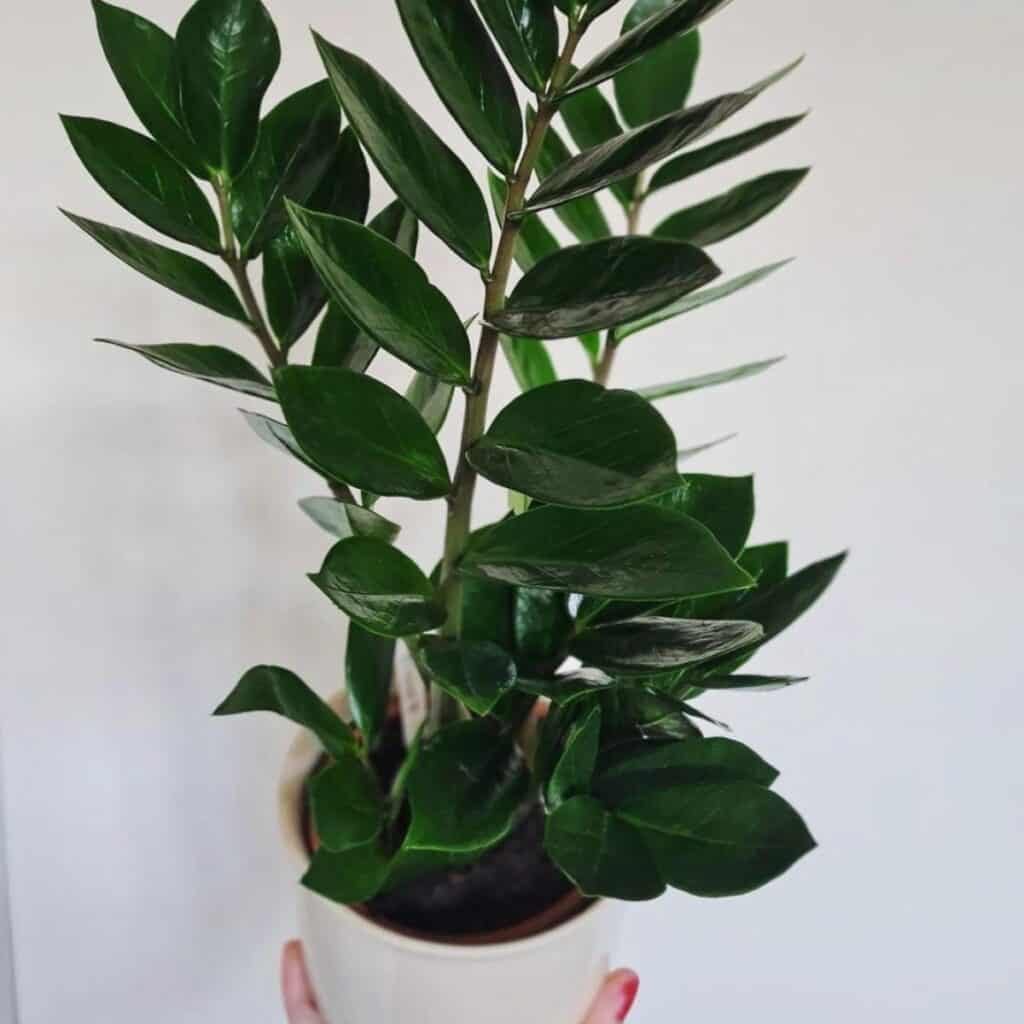

QUESTIONS
- What kind of light does Zee Zee plant need? It can thrive in low to medium, indirect light conditions. It’s perfect for rooms with limited natural light or those who forget to water their plants regularly.
- How often should I water Zanzibar Gem? Water your Zanzibar Gem infrequently, allowing the soil to dry out between waterings. This plant is very forgiving if you forget to water it occasionally.
- Can Emerald Palm grow in a variety of environments? The Emerald Palm is adaptable and can grow in a variety of environments. It can thrive in indoor spaces with average temperatures and humidity levels.
- Is Eternity Plant easy to care for? The Eternity Plant is easy to care for and requires minimal pruning and fertilization. It’s a great choice for busy people or those new to plant care. ZZ plants can experience some common issues (yellow leaves) but are generally quite hardy and resilient.
- Will Aroid Palm grow tall or spread out? The Aroid Palm typically grows up to 2-4 feet tall but does not spread out significantly. It’s a compact plant that can fit nicely in a corner or on a shelf.
Dracaena Sanderiana (Lucky Bamboo)
Botanical Name: Dracaena sanderiana
Common Names: Lucky Bamboo, Sander’s Dracaena, Ribbon Dracaena, Curly Bamboo, Chinese Water Bamboo, Goddess of Mercy’s Plant, Belgian Evergreen
Dracaena sanderiana is a tropical, evergreen plant native to Southeast Asia, particularly China and Japan. It’s not actually a true bamboo but a type of Dracaena.
Its distinctive curly stems and small, lush leaves give it a unique, eye-catching appearance, making it a beloved houseplant worldwide.
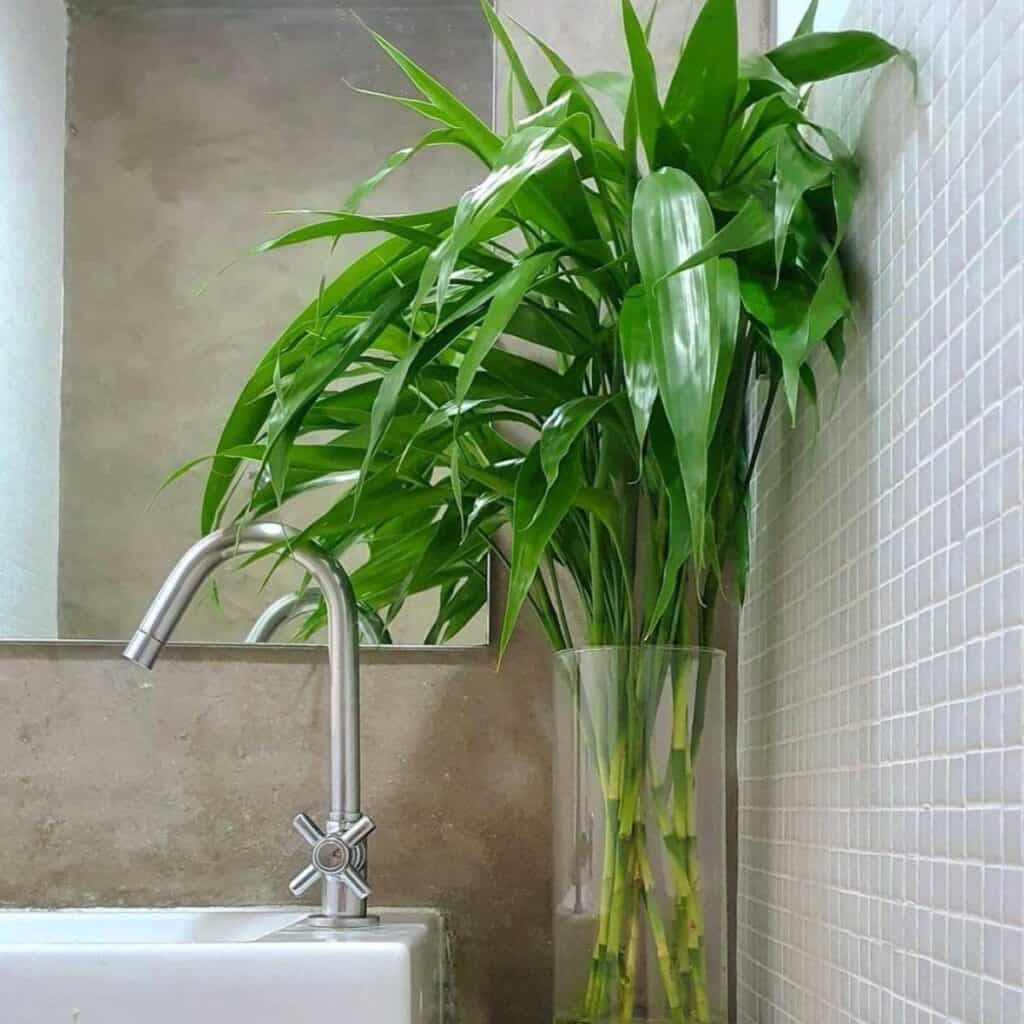

QUESTIONS
- What kind of light does Lucky Bamboo prefer? Lucky Bamboo prefers bright, indirect light but can also do well in lower light conditions. Avoid direct sunlight, which can scorch the leaves.
- How much maintenance does Sander’s Dracaena require? Sander’s Dracaena is relatively low-maintenance. It only needs occasional watering and pruning to keep it looking its best. However, it encounters several common diseases and problems, including root rot, pests, and yellowing leaves.
- Is Curly Bamboo toxic to pets? Unfortunately, yes. Curly Bamboo is toxic to pets if ingested, so it should be kept out of reach of curious animals.
- How tall does Chinese Water Bamboo grow? Chinese Water Bamboo can grow up to 3 feet tall but can be pruned to maintain a shorter height.
- What is Ribbon Dracaena’s reputation for being indestructible? Ribbon Dracaena is known for its ability to thrive in a variety of environments and can survive with minimal care. It’s a great choice for busy people or those new to plant care.
Peperomia (Radiator Plant)
Botanical Name: Peperomia spp.
Common Names: Radiator Plant, Baby Rubber Plant, pepper elder, shining bush plant, emerald ripper pepper
Peperomia is a genus of over 1,000 species of small, tropical plants native to Central and South America. They are known as “radiator plants” because they prefer warm, dry conditions similar to those found near a heating radiator.
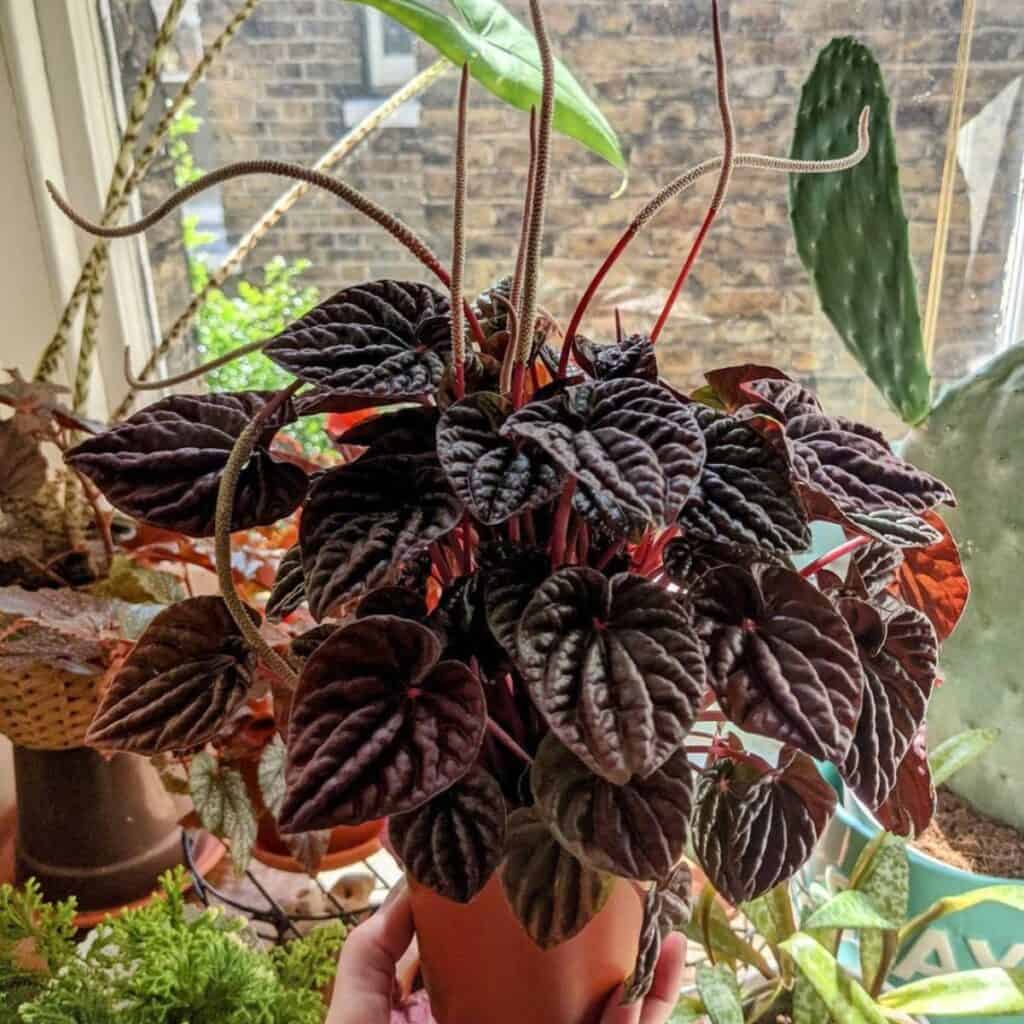

QUESTIONS
- What is the ideal lighting condition for the Radiator Plant? Peperomia prefers bright, indirect light. This means it likes to be near a window but not directly in front.
- How well does Baby Rubber Plant tolerate direct sunlight? This plant can tolerate direct sunlight, but it’s not the best. Direct sunlight can scorch the leaves, so it’s better to keep them in a spot with bright, indirect light.
- Can Shining Bush Plant thrive in low-light conditions? Yes, Shining Bush Plant can thrive in low-light conditions. It’s actually quite adaptable and can do well in rooms with limited natural light.
- Does Emerald Ripper Pepper require any special care for low-light conditions? No, Emerald Ripper Pepper doesn’t require any special care for low-light conditions. Just water it properly and prune off any dead or damaged leaves.
- Is the Peperomia plant a low-maintenance plant? Yes, Peperomia is considered a low-maintenance plant. It’s easy to care for and doesn’t require a lot of attention. Peperomia plants are relatively low-maintenance and not prone to serious illnesses as long as their basic care needs are met.
Philodendron Hederaceum (Philodendron)
Botanical Name: Philodendron hederaceum
Common Names: Heartleaf Philodendron, Philodendron Scandens
Philodendron is a lush, tropical evergreen vine native to the rainforests of Central and South America.
This climbing plant is known for its ability to trail and cascade, making it a versatile choice for indoor spaces and landscapes.
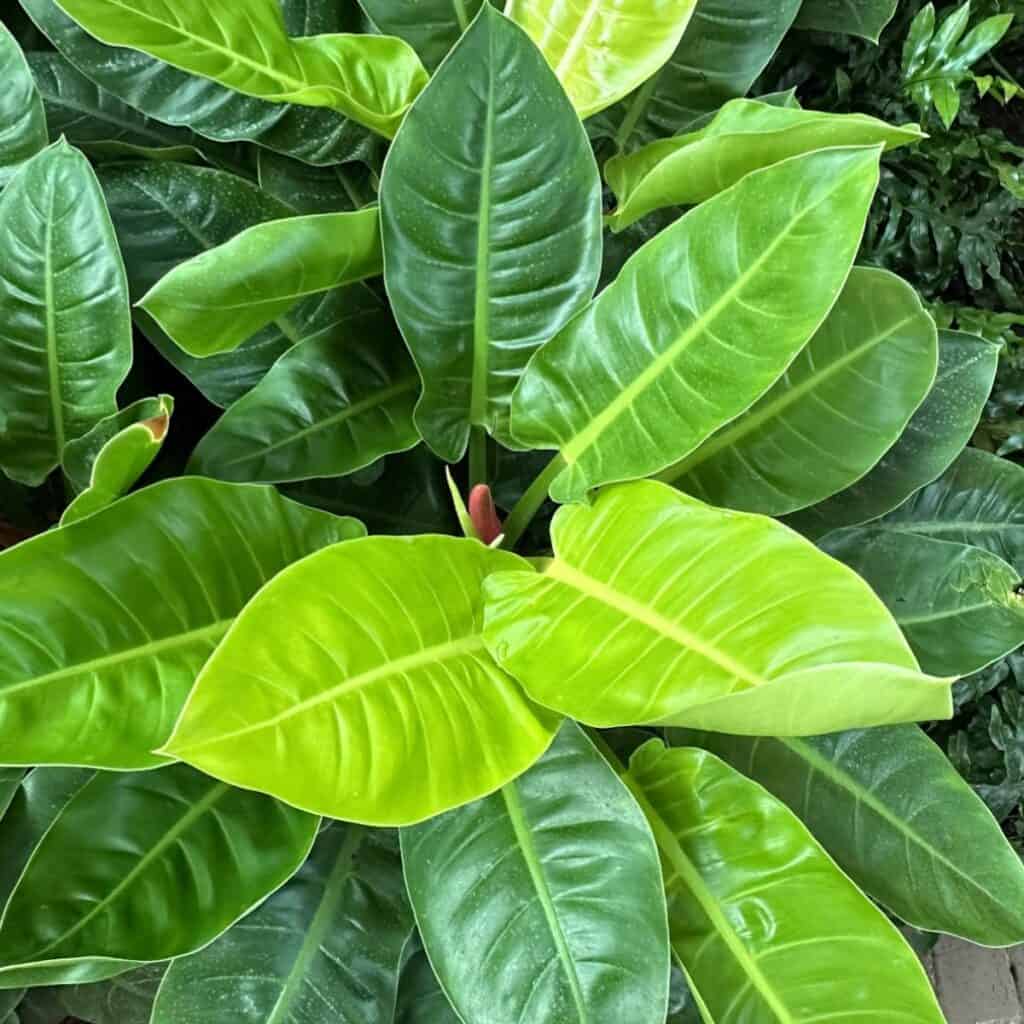

QUESTIONS
- What is the ideal lighting condition for Heartleaf Philodendron? Heartleaf Philodendron prefers bright, indirect light and can be damaged by too much direct sun exposure, which results in yellowing leaves. This means it likes to be near a window but not directly in front.
- How much maintenance does Philodendron scandens require? Philodendron scandens is relatively low-maintenance. It only needs occasional watering, balanced fertilizer, and pruning to keep it looking its best.
- How large can the Philodendron plant grow? Philodendrons can grow quite large, up to 12 inches long. But don’t worry—it’s easy to prune it back to keep it at a manageable size.
- Is Philodendron hederaceum pet-friendly? Unfortunately, no. Philodendron hederaceum is toxic to pets if ingested, so it’s best to keep it out of reach of curious animals.
- Are there any specific humidity or temperature requirements? Yes, Philodendron prefers moderate humidity and average household temperatures between 65-75°F.
Maranta (Prayer Plant)
Botanical Name: Maranta leuconeura
Common Names: Prayer Plant, Maranta
The Maranta, or Prayer Plant, is a charming tropical houseplant known for its unique leaves that fold up at night. With its compact size and non-toxic nature, the Maranta makes a safe pet plant and a great addition to any indoor space.
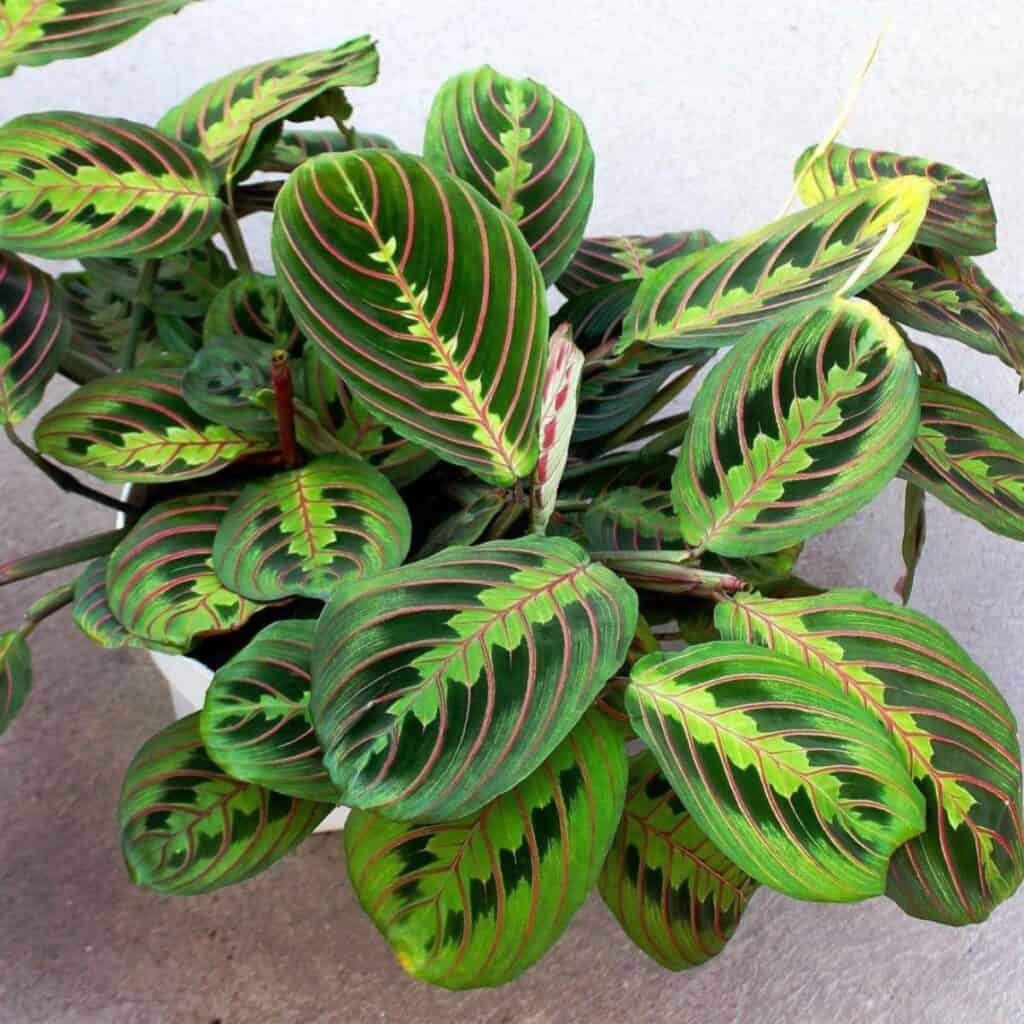

QUESTIONS
- Does the Prayer Plant grow well in low light? No, the Prayer Plant prefers bright, indirect light. It won’t do as well in low-light conditions.
- Can the Maranta plant tolerate direct sunlight? Not really. Direct sunlight can actually scorch the leaves, so it’s best to keep it out of direct rays to prevent yellowing leaves.
- How often should I water the Prayer plant? The Prayer Plant likes to have its soil partially dry out between waterings. Aim to water it every 1-2 weeks.
- Does the Maranta require special care? Not too much! The Maranta is relatively low-maintenance. Just give it the right lighting, soil, fertilizer, and water, and it should do great.
- Can I expect the Prayer plant to produce flowers? Unfortunately, the Prayer plant is not known for producing flowers indoors. Its real showstopper is the unique way its leaves fold up at night, giving it the “prayer plant” nickname.
Sansevieria Trifasciata (Snake Plant
Botanical Name: Sansevieria trifasciata
Common Names: Snake Plant, Mother-in-Law’s Tongue, Devil’s Tongue
The Snake Plant is a resilient, succulent perennial native to the tropical regions of West Africa. Its stiff, upright leaves give it a striking architectural appearance, making it a popular choice for modern indoor spaces.


QUESTIONS
- What is the Snake Plant’s tolerance for low light? The snake plant is highly tolerant of low light conditions and can thrive in areas with minimal natural or limited sunlight exposure.
- How much maintenance does the Mother-in-Law’s Tongue require? The Mother-in-Law’s Tongue is a low-maintenance houseplant, requiring infrequent watering and minimal care. It can tolerate irregular watering and neglect, making it an ideal choice for busy individuals or those new to plant care.
- What is the recommended location for Sansevieria trifasciata? Sansevieria trifasciata does well in various indoor locations, including offices, bedrooms, and living rooms, as they can adapt to different light conditions. They prefer well-draining soil and should be planted in containers with drainage holes to prevent root rot.
- What is the Devil’s Tongue’s size and growth habit? The Devil’s Tongue forms dense, upright clumps with stiff, sword-like leaves that can grow up to 2 meters tall in optimal conditions. It’s a slow-growing plant, spreading habit lasting 5-10 years or more with proper care.
- Are there any specific temperature or humidity requirements? Snake plants can tolerate a wide range of temperatures, from 50°F to 90°F, and do not have strict humidity requirements, making them suitable for most indoor environments. They prefer average humidity levels and should avoid cold drafts or direct heat sources.
Spathiphyllum (Peace Lily)
Botanical Name: Spathiphyllum
Common Names: Peace Lily, spathe flower, White Sails
The Peace Lily is a tropical perennial native to the rainforests of Central and South America. Its lush, dark green foliage and elegant white flowers make it a popular choice for indoor spaces.
This plant is known for its air-purifying abilities and low-light tolerance.


QUESTIONS
- What are the light requirements for a Peace Lily? Peace Lily prefers partial to deep shade. Avoid direct sunlight, as it can scorch the leaves and turn yellow.
- How much water does a Spathe Flower need? Keep the soil consistently moist but not waterlogged. Water your Peace Lily when the top inch of the soil feels dry.
- How big does Spathiphyllum grow? This plant can grow up to 6 feet tall, but they typically reach 3 feet high and wide indoors.
- Are White Sails pet-friendly? No, the White Sails plant is toxic to both humans and pets. Ingesting any part of the plant can cause irritation and burning sensations in the mouth, difficulty swallowing, and vomiting.
- How difficult are Peace Lilies to care for? Peace lilies are relatively low-maintenance plants, requiring only regular watering and occasional fertilization. They are forgiving of occasional neglect, making them an excellent choice for novice gardeners or those with busy schedules.
Dracaena (Dracaena fragrans ‘Compacta’)
Botanical Name: Dracaena fragrans ‘Compacta’
Common Names: Dracaena Janet Craig, Corn Plant, Dragon Tree
Dracaena fragrans ‘Compacta,’ commonly known as the Dracaena Janet Craig, is a popular indoor plant prized for its lush, glossy green foliage.
This tropical plant is native to Africa and belongs to the Asparagaceae family. It features rosettes of wavy, downward-curving leaves that grow from an upright central stalk, giving it an elegant architectural appearance.
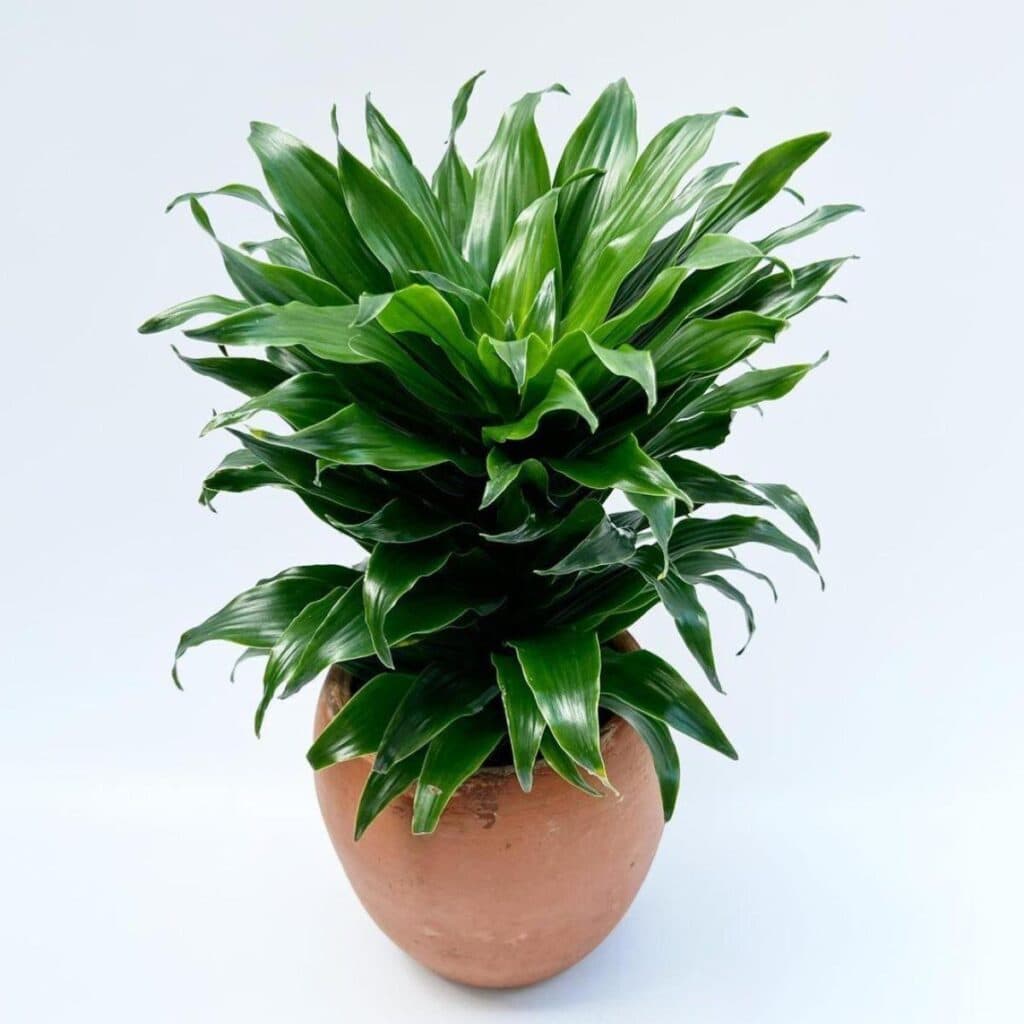

QUESTIONS
- What is the ideal lighting condition for Dracaena Janet Craig? This plant prefers bright, indirect light. It does best in a spot with plenty of ambient light but avoids direct sunlight, which can scorch the leaves.
- How well does the Corn Plant tolerate direct sunlight? The Corn Plant is not a fan of direct sunlight. Prolonged exposure to intense light can cause the leaves to fade and become discolored.
- Can Dragon Tree thrive in low-light conditions? Yes, the Dragon Tree is quite adaptable and can tolerate lower light conditions, though it may grow more slowly and have fewer leaves.
- Does Dracaena require any special care for low-light conditions? If growing in low light, you may need to water the plant less frequently to prevent overwatering and root rot. Fertilizing can also be reduced.
- Is Dracaena fragrans ‘Compacta’ a low-maintenance plant? Absolutely! This plant is considered a very low-maintenance houseplant. It only needs occasional watering and the occasional pruning to maintain its shape.
Rhapis Excelsa (Rhapis Palm)
Botanical Name: Rhapis excelsa
Common Names: Lady Palm, Bamboo Palm, Ground Rattan, Miniature Fan Palm, Fern Palm, Rhapis Palm, Broadleaf Lady Palm
The Rhapis Excelsa, commonly known as the Lady Palm, is an elegant and durable palm that can adapt to a wide range of conditions. This slow-growing palm features large, shiny, dark green fronds with blunt tips, giving it a unique architectural appearance.
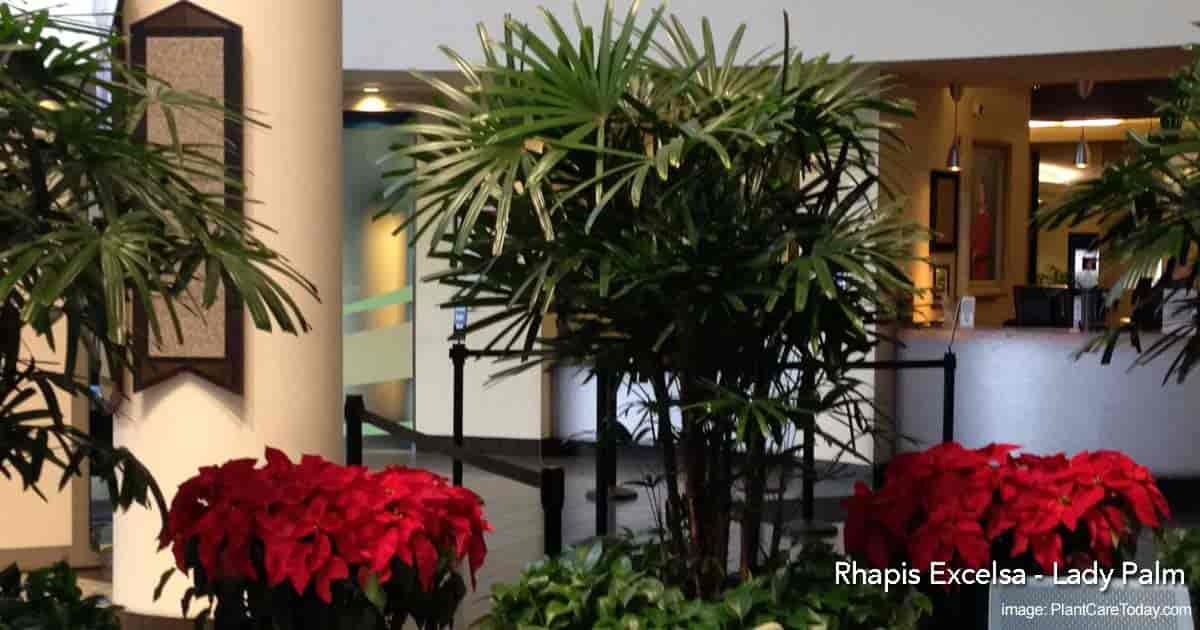

QUESTIONS
- What is the ideal lighting condition for Rhapis Excelsa? The Rhapis Excelsa prefers bright, indirect light. It can tolerate lower light conditions, but direct sunlight can cause the leaves to scorch.
- How well does Lady Palm tolerate direct sunlight? The Lady Palm can handle some direct sunlight, but prolonged exposure can cause the leaves to fade or become discolored.
- Can Ground Rattan thrive in low-light conditions? Yes, Ground Rattan can grow well in low-light conditions, though it may grow a bit more slowly.
- Does Broadleaf Lady Palm require any special care for low-light conditions? If growing in low light, you may need to water the plant less frequently to prevent overwatering and root rot. Fertilizing can also be reduced.
- Is Rhapis Palm a low-maintenance plant? Absolutely. The Rhapis Palm Palm is considered an easy-care houseplant. It only needs occasional watering and the occasional pruning to maintain its shape.
Howea Forsteriana (Kentia Palm)
Botanical Name: Howea forsteriana
Common Names: Kentia Palm, Thatch Palm, or Palm Court Palm
The Howea Forsteriana is considered one of the most beautiful palms in the world and is suitable for growing either indoors or outdoors.
Reputed to be one of the most sought-after indoor palms due to its upright, elegant appearance and general hardiness.
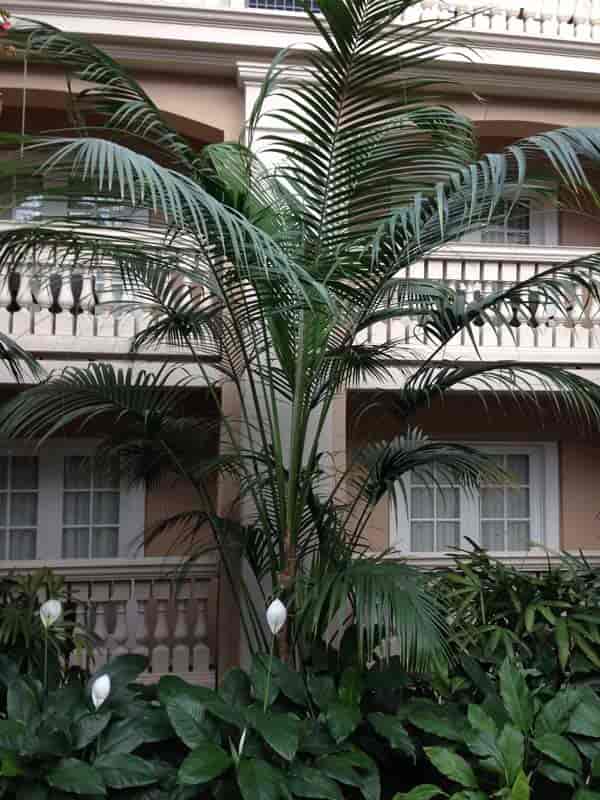

QUESTIONS
- What is the ideal lighting condition for Howea Forsteriana? It prefers bright, indirect light. It can tolerate lower light conditions, but direct sunlight can cause the leaves to scorch.
- How well does Kentia Palm tolerate direct sunlight? The Kentia Palm, plants with low sunlight needs, can handle some direct sunlight, but prolonged exposure may cause the leaves to fade or become discolored.
- Can the Thatch Palm thrive in low-light conditions? Yes, the Thatch Palm can grow well in low-light conditions, though it may grow a bit more slowly.
- Does Palm Court Palm require any special care for low-light conditions? If growing in low light, you may need to water the plant a bit less frequently to prevent overwatering and root rot. Fertilizing can also be reduced.
- Is Howea Forsteriana a low-maintenance plant? Absolutely. Yes, the Kentia Palm is considered an easy-care houseplant. It only needs occasional watering and the occasional pruning to maintain its shape.
Chamaedorea Elegans (Parlor Palm)
Botanical Name: Chamaedorea elegans
Common Names: Neanthe Bella Palm, Parlor Palm, Parlour Palm
The Chamaedorea Elegans, also known as the parlor palm, is a slow-growing, low-maintenance houseplant native to the rainforests of southern Mexico and Guatemala.
It features crescent-shaped, perforated leaves and flexible, spineless stems with small, inconspicuous yellow flowers that may lead to small berries.
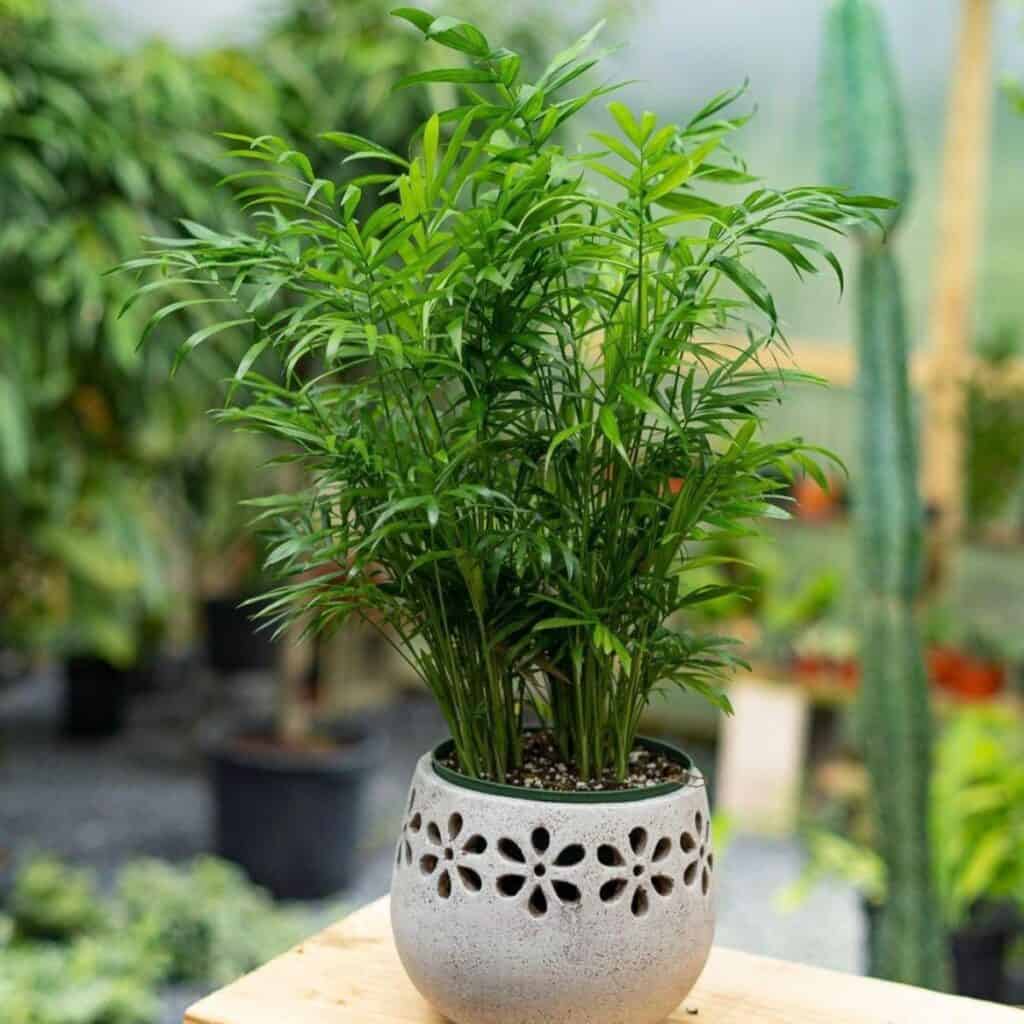

QUESTIONS
- What is the ideal lighting condition for Neanthe Bella Palm? The Neanthe Bella Palm prefers bright, indirect light to partial shade. It can tolerate lower light conditions, but direct sunlight can cause the leaves to fade or become discolored.
- How well does Parlor Palm tolerate direct sunlight? The Parlor Palm can handle some direct sunlight, but prolonged exposure can cause the leaves to scorch.
- Can Parlor Palm thrive in low-light conditions? Yes, the Parlor Palm can grow well in low-light conditions, though it may grow a bit more slowly.
- Does Parlour Palm require any special care for low-light conditions? If growing in low light, you may need to water the plant a bit less frequently to prevent overwatering and root rot. Fertilizing can also be reduced.
- Is Chamaedorea elegans a low-maintenance plant? Absolutely. Chamaedorea elegant is considered an easy-care houseplant. It only needs occasional watering and the occasional pruning to maintain its shape.
Some of the best low-light tolerant houseplants include Pothos, Snake Plant, ZZ Plant, Philodendron, and Dracaena. These resilient, adaptable plants can add a lush, green touch to even the darkest corners of your home or office.
So, while bright, indirect lighting is ideal for most plants, with the right low-light tolerant varieties, you can enjoy the benefits of greenery in those shadier spots. Just be sure to choose plants specifically suited to the lower light levels.




